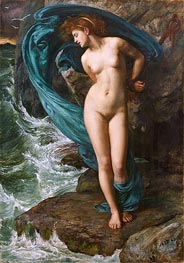
Sir Edward Poynter Painting Reproductions 1 of 1
1836-1919
English Victorian Romanticism Painter
Sir Edward Poynter's name might not ring as loudly as some of his contemporaries, but his impact on the Victorian art scene is unmistakable. Born in Paris on 20 March 1836 - the son of architect Ambrose Poynter - he was whisked back to Britain shortly after, setting the stage for a life steeped in artistic endeavor. His early years were shadowed by ill health, prompting winters spent in the milder climes of Madeira and Rome. It was in Rome, at just 17, that a chance meeting with Frederick Leighton would ignite a lifelong passion.
Upon returning to London, Poynter immersed himself in the world of art. He studied at Leigh's Academy in Newman Street, followed by the Royal Academy Schools. The allure of Parisian classicism drew him to the studio of Charles Gleyre, where he rubbed shoulders with the likes of James McNeill Whistler and George du Maurier. These formative experiences honed his skills, laying the groundwork for the grand historical paintings that would define his career.
In 1866, he married Agnes MacDonald - a woman whose family connections read like a who's who of British culture. Her sister Georgiana was wed to Edward Burne-Jones; another sister, Alice, was the mother of Rudyard Kipling; yet another, Louisa, was mother to Stanley Baldwin, future Prime Minister. Through these connections, Poynter found himself at the heart of Victorian cultural life.
Poynter's own sister, Clara Bell, made her mark as a translator of literary and scientific works. This familial backdrop of creativity and intellect perhaps fueled his ambitious projects. His "Israel in Egypt" (1867) showcased his penchant for grandiose historical themes, followed by "St George for England" (1869) - a mosaic gracing the Central Lobby of the Palace of Westminster. Arguably, his magnum opus was "The Visit of the Queen of Sheba to King Solomon" (1884–90), a canvas teeming with opulence and intricate detail.
His contributions weren't confined to the canvas. Poynter became the first Slade Professor at University College London from 1871 to 1875, nurturing the next generation of artists. Later, as principal of the National Art Training School from 1875 to 1881, and director of the National Gallery from 1894 to 1904, he wielded significant influence over British art education and curation. His election as President of the Royal Academy in 1896 - the same year he was knighted - cemented his standing in the art world.
Poynter's legacy is a tapestry of artistic achievement and institutional leadership. Though perhaps overshadowed by some of his peers, his works remain testaments to a meticulous craft and a grand vision. In 1995, his alma mater Brighton College paid homage with an exhibition titled "Life at Arms Length," a fitting reflection on an artist who, while deeply embedded in his era's cultural milieu, maintained a distinct and thoughtful perspective.
Upon returning to London, Poynter immersed himself in the world of art. He studied at Leigh's Academy in Newman Street, followed by the Royal Academy Schools. The allure of Parisian classicism drew him to the studio of Charles Gleyre, where he rubbed shoulders with the likes of James McNeill Whistler and George du Maurier. These formative experiences honed his skills, laying the groundwork for the grand historical paintings that would define his career.
In 1866, he married Agnes MacDonald - a woman whose family connections read like a who's who of British culture. Her sister Georgiana was wed to Edward Burne-Jones; another sister, Alice, was the mother of Rudyard Kipling; yet another, Louisa, was mother to Stanley Baldwin, future Prime Minister. Through these connections, Poynter found himself at the heart of Victorian cultural life.
Poynter's own sister, Clara Bell, made her mark as a translator of literary and scientific works. This familial backdrop of creativity and intellect perhaps fueled his ambitious projects. His "Israel in Egypt" (1867) showcased his penchant for grandiose historical themes, followed by "St George for England" (1869) - a mosaic gracing the Central Lobby of the Palace of Westminster. Arguably, his magnum opus was "The Visit of the Queen of Sheba to King Solomon" (1884–90), a canvas teeming with opulence and intricate detail.
His contributions weren't confined to the canvas. Poynter became the first Slade Professor at University College London from 1871 to 1875, nurturing the next generation of artists. Later, as principal of the National Art Training School from 1875 to 1881, and director of the National Gallery from 1894 to 1904, he wielded significant influence over British art education and curation. His election as President of the Royal Academy in 1896 - the same year he was knighted - cemented his standing in the art world.
Poynter's legacy is a tapestry of artistic achievement and institutional leadership. Though perhaps overshadowed by some of his peers, his works remain testaments to a meticulous craft and a grand vision. In 1995, his alma mater Brighton College paid homage with an exhibition titled "Life at Arms Length," a fitting reflection on an artist who, while deeply embedded in his era's cultural milieu, maintained a distinct and thoughtful perspective.
2 Edward Poynter Paintings

Andromeda 1869
Oil Painting
$1705
$1705
Canvas Print
$56.39
$56.39
SKU: POY-16472
Sir Edward Poynter
Original Size: 51.3 x 35.7 cm
Private Collection
Sir Edward Poynter
Original Size: 51.3 x 35.7 cm
Private Collection

Faithful Unto Death 1865
Oil Painting
$2046
$2046
Canvas Print
$56.39
$56.39
SKU: POY-16877
Sir Edward Poynter
Original Size: 115 x 75.5 cm
Walker Art Gallery, Liverpool, UK
Sir Edward Poynter
Original Size: 115 x 75.5 cm
Walker Art Gallery, Liverpool, UK